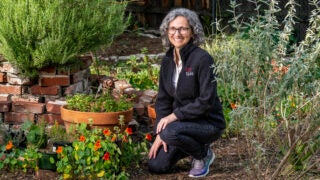Affordable housing solutions are evasive for homeless veterans in Los Angeles
USC/RAND study tracks obstacles for military veterans searching for housing. Los Angeles is home to 10% of the nation’s unhoused veterans.
The fate of unsheltered veterans in Los Angeles is worrisome, with many at risk of street homelessness. An intensive, yearlong report by USC and RAND Corp. researchers reveals a series of obstacles standing between unhoused veterans and long-term housing.
Los Angeles is epicenter for homeless veterans
With 10% of all unhoused veterans living in Los Angeles, it’s the most viable place to study the issue and seek solutions.
The study — “Twenty-Six Veterans: A Longitudinal Case Study of Veterans Experiencing Homelessness in Los Angeles, 2019-2020” — is the first to systematically track veterans experiencing homelessness in the city.
Researchers from USC and RAND Health Care Access and Delivery followed 26 homeless veterans in West L.A. Most had honorable discharge status. All live close to the Department of Veterans Affairs’ West L.A. campus. Most do not access VA benefits.
“The study was designed for increased depth rather than breadth,” said Ben Henwood, an associate professor at the USC Suzanne Dworak-Peck School of Social Work and coauthor of Housing First, which documents a paradigm-shifting evidence-based approach to ending homelessness.
“We wanted to make sure we really understood the trajectories and stories of a smaller sample rather than have a more limited understanding across a larger sample.”
Henwood coauthored the report with Sarah Hunter, senior behavioral scientist at RAND Corp. They set out to determine how many veterans had found housing, what their experiences were like as they searched for it, and the ways that housing affected their well-being. Participants were invited to be interviewed every month for a year.
Vulnerable and disabled veterans suffer the most
Veterans in the study are suffering poor health and well-being. Illicit drug use, physical and mental health disorders and serious crime victimization are contributing factors.
Housing was a priority for virtually all veterans experiencing homelessness in the study, but many are discouraged and don’t believe in their ability to find and keep housing.
Key findings of the USC/RAND report on homeless veterans:
Key findings include:
- Those who have found stable housing reported better quality of life and were more likely to access medical treatment and VA benefits.
- Of the 26 veterans involved in the study, 17 found some form of housing over the course of the year, but most were housed in transitional programs.
- Only three obtained permanent housing.
- Most do not believe they can obtain housing through the VA.
- Pandemic-related programs boosted the participants’ success rate. The closure of those programs will negatively impact veterans seeking housing.
- Outreach efforts by L.A. County, the VA and other entities seeking to assist veterans need to be coordinated.
Many veterans find barriers in finding affordable housing
Many participants are unsatisfied with the housing options available to them, yet the housing preferences of this population are somewhat unclear. Dissatisfaction with housing options leads some to say they prefer to remain homeless, but Henwood is wary of misperceptions that may be drawn from the survey.
“Choosing to remain unsheltered and on the streets doesn’t mean that people want to be homeless,” he said. “Instead, it reflects the limited and poor options that our systems afford people in need.”
Solutions require more affordable housing and proactive support
Recommendations include expanded and coordinated outreach, the use of mobile technology and a housing first approach. Instilling a sense of urgency is key to any successful strategy surrounding veteran homelessness.
“We obviously need more affordable housing in Los Angeles and nationally, but we also shouldn’t expect homeless veterans to navigate finding what limited housing is available on their own,” Henwood said. “Our systems need to be more proactive.”



